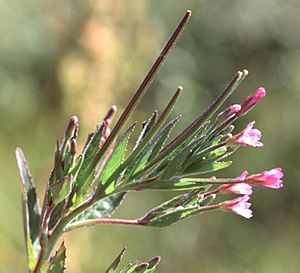Fringed willowherb facts for kids
Quick facts for kids Fringed willowherb |
|
|---|---|
 |
|
| Epilobium ciliatum subsp. watsonii | |
| Scientific classification | |
| Genus: |
Epilobium
|
| Species: |
ciliatum
|
| Synonyms | |
|
Epilobium adenocaulon Hausskn. |
|
Epilobium ciliatum, also known as fringed willowherb or American willowherb, is a type of flowering plant. It belongs to the willowherb family, called Onagraceae. This plant naturally grows in many parts of North America, southern South America, and East Asia. It has also spread to many areas in Europe, Asia, and Australia.
This plant is a perennial herbaceous plant, which means it lives for more than two years and has soft stems. It often grows in wet places like wetlands. However, you can also find it in many other areas, including disturbed ground and along roadsides. It grows at elevations below 1,400 meters (about 4,600 feet).
Plant Description
Epilobium ciliatum is a plant that grows in clumps. It often reaches more than 1.5 meters (about 5 feet) tall. Its leaves are shaped like spears and have thick veins. The leaves near the bottom of the plant can be up to 15 centimeters (about 6 inches) long. The leaves, stem, and flower clusters are covered with tiny, stiff hairs and glands.
The flowers of this plant have four sepals, which are like small leaves that protect the bud. The trumpet-shaped flowers have four petals. These petals are so deeply cut that they look like four pairs. Their color can be white, light purple, or pink, often with dark lines. Each flower has eight stamens, which produce pollen. It also has a club-shaped stigma, which receives pollen.
After the flower blooms, it forms a narrow, hairy fruit. This fruit is a capsule with four sections. It can grow up to 10 centimeters (about 4 inches) long. The fruit might be held on a long stalk. The seeds inside are covered with soft, downy hairs. These hairs help the seeds float easily on the wind for long distances.
Plant Subspecies
Scientists recognize three main types, or subspecies, of Epilobium ciliatum:
- Epilobium ciliatum ssp. ciliatum
- Epilobium ciliatum ssp. glandulosum — (Lehm.) Hoch & P.H.Raven
- Epilobium ciliatum ssp. watsonii — (Barbey) Hoch & P.H.Raven
Plant Taxonomy
Scientists sometimes think that Epilobium ciliatum might be a "cryptic species complex." This means it could be a group of different species that look very much alike. For example, the Rocky Mountain Willowherb (Epilobium saximontanum) is sometimes considered another subspecies of Epilobium ciliatum.
It's also possible that the three subspecies we know today are actually separate species. If this were true, E. ciliatum ssp. watsonii might be called E. adenocaulon. And E. ciliatum ssp. glandulosum might be called E. bergianum. The remaining plants would still be called E. ciliatum ssp. ciliatum.
Where the Plant Grows
Epilobium ciliatum is native to the southern parts of Canada and most of the United States. It arrived in northern Europe in the early 1900s and quickly spread. It reached Finland around 1920. This plant likes to grow in damp places. You can find it along streams, in ditches, near ponds, in gardens, along roadsides, in recently cleared areas, and on unused land.
See also
 In Spanish: Epilobium ciliatum para niños
In Spanish: Epilobium ciliatum para niños

